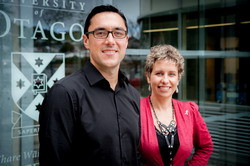In 2010 a paper published in the International Journal of Cancer showed that Māori have the highest rate of testicular cancer in New Zealand1. Intrigued by the paper’s findings, Dr Jason Gurney is embarking on a programme of research to find out why Māori are the only non-white population in the world to have the highest rates of this cancer.
Dr Gurney (Ngāpuhi, Ngati Hine) was awarded a 2014 HRC Eru Pōmare Research Fellowship in Māori Health to carry out his study of testicular cancer at the University of Otago, Wellington. His supervisor and mentor for this study is Associate Professor Diana Sarfati, lead author of the 2010 paper which first sparked his interest in testicular cancer.
“It was one of the first papers I read when I started working with Diana at the University of Otago, Wellington’s Department of Public Health. The paper showed that Māori have 50 per cent higher rates of testicular cancer than European New Zealanders. This is in stark contrast to other countries where European males suffer up to five times the rates of testicular cancer compared to other ethnic groups. That’s what makes this New Zealand finding so puzzling,” says Dr Gurney.
Perhaps even more perplexing though was the finding that Pacific men in New Zealand have very low rates of testicular cancer. Māori men are about three times more likely to have testicular cancer than Pacific New Zealanders. Dr Gurney refers to this as the ‘Polynesian paradox’, where “two Polynesian populations residing in the same country experience a vastly different burden of disease”.
“This is one of the very rare occasions where Māori and Pacific peoples don’t move in parallel with respect to the incidence of a given cancer or disease. It may well be the lynchpin in this whole mystery, because if we can explain why Māori have such high rates of testicular cancer and Pacific peoples such low rates, then we have a good chance of explaining what’s causing testicular cancer – and that would be ground-breaking.”
Dr Gurney’s fellowship will involve piloting the first case-control study of testicular cancer to be performed in New Zealand. It will also draw on his lead-authored paper published in The Journal of Urology2 which found that ethnic patterns of undescended testes, where the testes fail to reach the normal position in the scrotum, mirrored those observed for testicular cancer.
“Undescended testes is one of the few known risk factors for testicular cancer. We found that Māori had higher rates of undescended testes than all other ethnic groups, with Pacific and Asian groups having the lowest rates. Since the main risk factors for undescended testes occur in the womb, this suggests that the ethnic patterning of testicular cancer is at least partly due to prenatal risk factors.”
Dr Gurney and his research team are currently in the process of developing the design for the case-control study, which he says will require about 1000 participants. Maternal smoking, low birth weight and short gestational duration, as well as pre- and post-natal exposure to cannabis, are just a few of the potential risk factors his group will be exploring. Study participants will also undergo blood tests to account for any possible genetic risk factors.
“It’s a bit like looking for a needle in a haystack, as there are so many exposures that have been linked to testicular cancer,” says Dr Gurney. “As soon as we can pinpoint which risk factors are more important than others, then we can start to look at prevention. We can’t prevent a disease if we don’t know what causes it.”
Dr Gurney says his HRC-funded fellowship – which will allow their group to pilot the case-control study, before seeking additional funding to complete it – is a unique opportunity to not only explain why Māori have the highest rates of testicular cancer in New Zealand, but also to help pinpoint what causes testicular cancer in general, something which has eluded the global research community to date.
1Sarfati D, Shaw S, Blakely T, Atkinson J, Stanley J. (2010) Ethnic and socioeconomic trends in testicular cancer incidence in New Zealand. International Journal of Cancer: 128, 1683–1691.
2Gurney J, Sarfati D, Stanley J, Studd R. (2013) Do ethnic patterns of cryptorchidism reflect those found in testicular cancer? The Journal of Urology, Vol. 190, 1852–1857.
